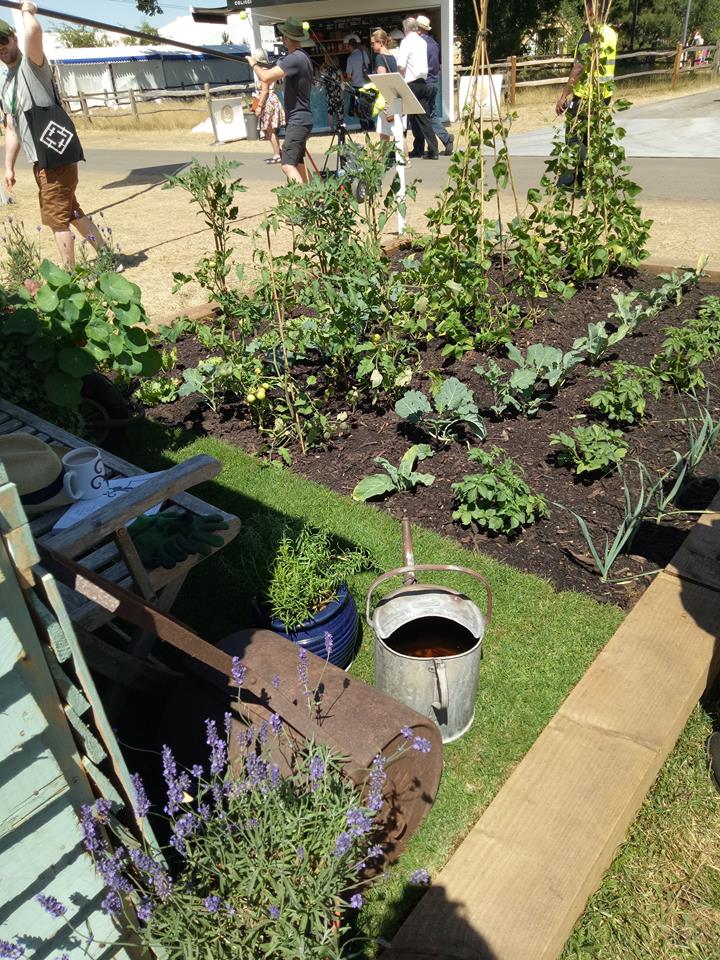Alice’s Hampton Highlights
I was fortunate enough to go to the RHS Hampton Court Flower Show on media day (2nd July). The gardens were stunning, like the weather. I had a really good day and so wanted to share my highlights with you, many of which I hope will give you, the Cultivation Street readers, ideas or will be something you can relate to.
There's everything from the gardens David designed, to a dinosaur head and a pineapple garden. Enjoy!
Celebrity Theatre
The Celebrity Theatre, sponsored by Everest, gave a range of celebrities the opportunity to talk on various subjects that they’re passionate about. The celebrities included giants of the horticultural world, such as David Domoney, and Carol Klein, as well as other household stars, like Julia Bradbury and Bill Oddie.


One of the talks that I was lucky enough to attend and which I thought would be really useful to you, the Cultivation Street clan, involved a discussion of volunteers in the community. The points that stood out are as follows:-
What works well when recruiting volunteers
- Taster sessions – an opportunity for people to come and experience what it’s like to be a volunteer.
- One off events – A garden party, or community garden clean up – this can include organisations, schools, general public etc.
- Workshops – For example, having a workshop to build a bug house hotel.
- Word of mouth – People who have attended a volunteer session or event telling their friends and family.
- Family friendly events – Adapt them to the season – Summer fete, carnival, Christmas party etc.
- Accreditation for training – Becoming a social enterprise – more information can be found at https://www.tcv.org.uk/learning
- Offering a range of positions that either suit the volunteers current skills, or an opportunity to learn – i.e. social media, carpentry, gardening etc.
- Online templates – i.e. an event checklist, risk assessment, informal job description – so a volunteer can see what they are going to get from that role (useful for a person’s future CV) – if they know the type of things they will be doing it will make the role more appealing.
Top tips
- Run environmental days –the environment agency can be approached to come and help a community or school group for free – this is also an opportunity to train new volunteers on the job
- Create a community pay back scheme – these give diverse communities the opportunity to swap skill sets, e.g. one community might be good at heavy digging, while another is better at rose pruning, swapping gardens for short periods can get people working to the best of their abilities and improving multiple gardens at the same time
- Trees to cities corporate days - http://t.co/ZVGYNJptPb
- Plan diverse activities – have a range to suit the mixture of people in your group as well as the weather conditions in your local area - it doesn’t always have to be horticulture based, of course! Upcycling and table top crafts are all good ways to get people involved.
Everest garden displays, designed by David Domoney –
- Mend Our Mountains garden display, supported by Julia Bradbury: When designing this display, David was inspired by the charity Mend Our Mountains who repair pathways around mountains in the UK. The garden has a rugged mountain feel with slate obelisks, steadfast alpine plants, and a Pavestone porcelain path in the blue-purple of natural slate to evoke the beauty and majesty of mountains.
- Mesothelioma UK garden display, supported by Carol Klein: This garden was inspired by the Mesothelioma UK charity that supports people suffering from asbestos-related cancer. Its central propeller water feature represents sufferers from the Merchant Navy who inhaled asbestos on the job. Etched onto the propeller are little Forget-me-not flowers, a symbol of the charity. A stark white Pavestone porcelain path sweeps through the garden to the front door.


- The Woodland Trust garden display, supported by Bill Oddie: Inspired by the Woodland Trust who maintain and restore our woodland areas, this display contains plants that are often found in UK forests. It doesn’t feel like a front garden and that’s why it’s special, it feels more like a nature space in which to unwind and de-stress.

My favourite gardens!
WW1 trenches –
This garden immersed visitors in the reality of our world war history – you didn’t just get to see and smell the garden, but experience it full-force! With an audio playing battlefield noises, the high walls, barbed wire, and not knowing what was around the next corner, the designers really took you back in time. At the end of the garden was a memorial of 24 ceramic poppies and a plaque recording the names of the 24 men that lost their lives from the Royal Park. The props were even from WW1 – I couldn’t believe it, right down to the barbed wire and horseshoes! (Head over to our Instagram page - @Cultivation Street for a video in the trench!)

Discover the evolution plants –
A garden called ‘Evolve through the roots of time,’ took you on a journey through 450 million years of plant evolution. It included 4,000 plants and more than 10 tonnes of topsoil. I really liked this garden because I learnt so much on the walk through it by reading the signs and seeing the ancient plants. It featured some pretty unusual and exotic species, ranging from simple ferns right through to lipstick-red peace lilies. Unbelievable! I thought this was great for both adults and children alike – it was really creative and interactive (especially the dinosaurs head! Wow, I know a certain someone who would have loved this feature).



Shed X
A big reason I wanted to experience Hampton Court Flower Show was to see this community’s exhibit. It was great to be able to speak to Robin, from the Community Brain about ShedX and the future of the project.
The ShedX, which took around 3 days to build at Hampton Court Flower Show is a community-led regeneration project in Tolworth. The heritage shed, which has been inspired by both historic and present allotment growing plots in Tolworth, was designed by a group of students at Kingston University (many of whom are still helping out, even though their section of the project has technically been completed!).
Now that the show is over, the vegetation from this exhibit will go to the community and ShedX will go to Lambeth Museum where it will be exhibited for 3 and a half weeks longer.
At this point, it will tour Tolworth and Surbiton inspiring people to go green where they live by holding workshops, assisting with resources and hopefully encouraging people to take back control of where they live. The Community Brain team want the community to have a say on the content, place and time of workshops should be, in order that they can best serve the communities involved. They will also be showing people how to grow their own vegetables and be environmentally friendly as well as involving 4 local primary schools by giving them the opportunity to eat a meal produced by the community kitchen.
For more information on ShedX follow this link!





Lifestyle gardens – Family Garden
This garden stood out to me because the wall was designed to be a giant bug hotel. I thought it was something a lot of the Cultivation Street communities could relate to or take ideas from. The Designer Lilly Gomm wanted to create a functional, family friendly garden – which is what many of us will aspire to creating, of course. Lily is said to have been inspired by the long-lasting and captivating effect a garden can have on children, somewhere for them to explore the various wildlife that the garden attracts as well as a place to play and learn.


Mr Men garden – designed by children with cancer -
Silver medal
This garden was so different from anything I’ve ever seen before, but as soon as I saw it I knew it was the Mr Men. Two towering hills of vibrant green grass faced one another, with two opposing houses at the top of each one – one for Mr. Happy, one for Mr. Worry. The colours and shapes of the features were designed to a T and really caught the essence of what it must be like as a child, or family of a child, going through the experience of cancer. One half is brightly coloured representing feelings of happiness while the other is a contrast with purples and blues showing the worry. This garden celebrates 30 years of the charity Children with Cancer UK. Before I even got chance to read what the garden was about it really caught my eye – a true showstopper
Pineapple garden – Great gardens of the USA: The Charleston & South Carolina Garden
Some icons that really catch my eye when buying pretty much anything at the moment are pineapples, flamingos and palm trees – you can generally find them all in hot countries, maybe that’s why I like them so much!
Well, this garden really caught my eye because it features a massive display of pineapples. This is why I refer to it as ‘the pineapple garden,’ although its real name was actually “Great Gardens of the USA: The Charleston and South Carolina Garden” and it was intended to represent the history and spirit of the city of Charleston in South Carolina.
The pineapples were there to represent locality and as you walked into the garden the pineapple railings told a story – a ship’s captain would stick a pineapple on a spike outside his house to indicate visitors were welcome as he had returned from sea.

School Scarecrow competition
I couldn’t believe how many schools had entered the scarecrow competition at Hampton this year! The theme was ‘you are what you eat,’ and I was so impressed by all of the contributions. They were exceptionally creative and some of the names gave me a real giggle– the one I remember was Old Mrs Sage, most her body was Sage and she wore an older ladies style hat – she reminded me of the nursery rhyme Old Mother Hubbard.
The top prize was £200 of gardening vouchers for the winning school and a certificate signed by Hampton Court Palace’s panel of judges. A dedicated kids’ area with a variety of fun activities happening throughout the week made this a great day out for children.


